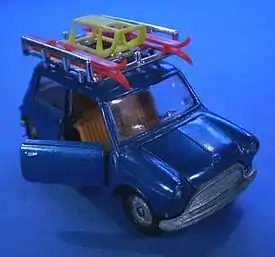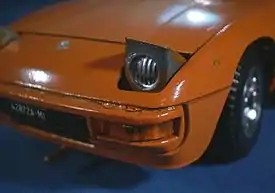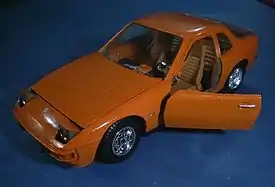Mebetoys
Mebetoys was an Italian toy manufacturer that produced die-cast model cars during the 1960s and 1970s. The company was purchased by Mattel in 1969. Mebetoy's main competition in Italy was the earlier trailblazer Mercury, Polistil and the rarer Ediltoys.

History
The Gran Toros website says that Mebetoys was started by the Besana family (Ugo,Mario and Martino) in 1959 as a toy die casting company, in Milano,Lambrate, Italy . The name comes from MEccanica BEsana TOYS. A diecast car line was started in 1967 (Rixon 2005, p. 36), rather late compared to the entry of many other companies in the early-to-mid-1950s. In detail and proportion, Mebetoys joined superior model producers of French Solido and fellow Italian Polistil, in many ways these became the triumvirate of diecast models on the European continent, though Danish Tekno and Italian Rio Models also were important. Models were exact to scale with many moving parts, and generally more sophisticated than venerable British producers Corgi and Dinky Toys. in 1976 Ugo start a new company, Verbes produce girls toys later take over from his douther Antonella as Dimian in Germany and HK.
Model Details
Mebetoys models were known for well-done castings (Rixon 2005, p. 80). Some were very clever model selections such as the Autobianchi A66 Elaf petroleum with a roof luggage rack carrying two large plastic oil barrels, or the Porsche 912 Rally (a 911 in rally form) with rock guards in thin yellow plastic strips covering the front windshield and hood and also featuring red and chrome body and bumper supports which extended from front to rear bumper. This car, in 1:43 scale, was topped off, literally, with three spare tires on the roof. Mebetoys Innocenti Mini (Italian-made mini) appeared in several different guises – including with skis and sled on its roof rack. Other models were unique because they were not offered elsewhere, like the ISO Fidia S4 grand touring sedan. Politoys had the Rivolta and Corgi and Matchbox made the Grifo ubiquitous, but nobody else made the Fidia S4. Models such as the Lamborghini Urraco, Maserati Bora, Toyota 2000 GT, and Ferrari 365 GTC-4 were also special and not often seen in 1:43 scale. Corgi Toys made the Bora, but the Mebetoys version was much better proportioned, detailed and painted (Gardiner and O'Neill 1996, p. 74).

Sinclair's Auto Miniatures, largely responsible for bringing the diecast collector hobby to the United States, discussed that many people were not aware that Mebetoys also made a few promotional issue diecast cars (Sinclair's 1977; Levine 2009). In the 1960s the company issued a couple of 1:24 scale Alfa Romeos, referred to as the "le veterane" set. These two cars were a 1925 P2 World Champion Grand Prix car and a 1951 Alfetta racer. They had exquisite detail with rubber tires and were mounted on a wood base with a decorative identification plate and covered with a clear plastic display box. These were reissued in the late 1970s (Sinclair's 1977).
The original Mebetoys logo was an 'opening eye' that looks very similar to the American CBS TV logo. Packaging was often a wood grain beige style with a plastic window – always including the 'eye' logo. Some boxes were other colors like a bright yellow. Then Mattel took over and the Mattel red pointed circle was added alongside the Mebetoys logo.
Changes by Mattel
In 1969, Mebetoys was bought by Mattel, which carried on Mebetoys models and began to market new 1/43 scale cars (Force 1992, pp. 146–147). At first, these were the same realistic Mebetoys European models and had many opening features, rubber tires, and excellent detail.
Gran Toros and customs
Incrementally, however, Mattel changed many aspects of Mebetoys. Hard plastic 'speed' tires replaced rubber and new California custom body designs were introduced in 1:43 scale and marketed as Hot Wheels Gran Toros, though they still said Mebetoys on the base. Thus the marque became less 'European' with more Mattel influence.
In order to attract buyers in the U.S. market, models like the realistic Toyota 2000 GT were augmented with ones such as Tom Daniel's fantasy custom Twin Mill (a model still used in the standard Hot Wheels line). The Hot Wheels flames-off-the-wheel emblem was applied to some Mebetoys packaging. "Hot Wheels" was translated into Italian as "Sputafuoco", or literally, the cars that "spit fire". Thus Mebetoys were marketed as a sort of larger Hot Wheels range. In an interesting twist Mattel's 'Flying Colors' normal sized smaller Hot Wheels were offered in Italy in Italian Mebetoys boxes in the late 1970s. The 1:43 scale line was discontinued entirely around 1983.
Larger sizes

Mebetoys under Mattel also made a 1:24 scale line which included a BMW 323 coupe, Porsche 924, Porsche 928, Ford Fiesta, Citroen Dyane (one with Zodiac style rubber boat!), Citroen Visa sedan, Alfa Romeo Alfetta (one in Cariabinieri livery), Alfa Alfasud Sprint, Alfa Giulietta sedan, FIAT Uno sedan, Volkswagen Beetle, Volkswagen Golf sedan, Talbot Horizon sedan / Simca 1308 sedan, Mercedes-Benz 450 SEL sedan, Opel Kadett, a Land Rover (one outfitted for desert photography), and a Lancia Beta coupe – one variation of which came handsomely equipped with bicycle rack and two bikes. These were well detailed, but for comparison of 'family' brands, the paint was done better on the later 1:24 scale Besana brothers Martoys. A few 1:30 scale trucks and vans were also made, like the FIAT 242 Attrez-Raid Rally Van.
Why so many of the 1:24 scale vehicles were rather mundane sedans is an interesting question since manufacturers often make sportier cars for play. Whether any of these were used for promotional purposes is unknown. Some of the later cars (and some of the last made by Mebetoys) had rather fat plastic tires and unwieldy wheel designs.
Some of the cars seemed spot on in detail and proportions like the Porsche 924 and the Volkswagens. Others were less confident in their realism. The Porsche 924 had nearly perfect proportion and the details were exquisite. The wheel design was generic but detailed and attractive with five larger and five smaller slots. Everything opened, including the rear plastic hatch. Even the hidden headlights popped up by moving a lever at the front of the chassis. When fully opened, however, the headlight lever stuck out from under the front bumper like some kind of strange antenna. The seats tilted forward, but chrome plating the steering wheel and gear shift was not so realistic. Another negative was that though the doors opened they did not include the door frame window surround.
Diecast legacy
The Gran Toros website again states that the Mebetoys company was founded by Ugo and Martino Besana in 1959. Mario Besana joined the company in 1967, one year after the company started producing cars. After selling the brand to Mattel, the Besana brothers set up Martoys. This firm made car models in 1/24-scale for only two years, from 1974 to 1976. Then, possibly because of confusion with Louis Marx and Company, the name was changed to Bburago, with two 'Bs' (the first B stood for the creator's name, Besana, while the remainder was for the town of Burago di Molgora where the models were made). Bburago became probably the most well-known and popular producer of 1:18 scale models through the 1980s and 1990s. Bburago's assets were sold in 2006 to Maisto.
References
- Force, Dr. Edward. 1992. Classic Miniature Vehicles Made in Italy. West Chester, Pennsylvania: A Schiffer Publication. ISBN 0-88740-433-2.
- Gardiner, Gordon, and O'Neill, Richard. 1996. The Collector's Guide to Toy Cars: An International Survey of Tinplate and Diecast Cars from 1900. London: Salamander Books, Ltd. ISBN 0-517-15977-5.
- The Gran Toros Website.
- Levine, R. F. 2009. David Sinclair in the Driver's Seat. Lake Erie LifeStyle, web published December 1.
- Rixon, Peter. 2005. Miller's Collecting Diecast Vehicles. London: Miller's, a division of Mitchell Beasley. ISBN 1-84533-030-7.
- Sinclair's Auto Miniatures. 1977. Typewritten newsletter, flyer focusing on Cursor. August. Erie, Pennsylvania.
- Rampini Paolo , Modelcars made in Italy 1900-1990 , Nada Editore , 2003 , ISBN 88-7911-308-9 .